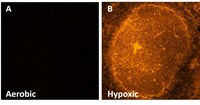EF5011-250UG Sigma-AldrichAnti-EF5 Antibody, clone ELK3-51 Antibody, Cyanine 3 conjugate
The EF5 hypoxia detection method provides a sensitive and quantitative method to detect and measure tissue hypoxia in animal and human tumors, normal tissues and cells.
More>> The EF5 hypoxia detection method provides a sensitive and quantitative method to detect and measure tissue hypoxia in animal and human tumors, normal tissues and cells. Less<<Recommended Products
Overview
| Replacement Information |
|---|
Key Spec Table
| Species Reactivity | Key Applications | Host | Format | Antibody Type |
|---|---|---|---|---|
| R, M, H | IHC, IF | M | Cy3 | Monoclonal Antibody |
| References |
|---|
| Product Information | |
|---|---|
| Format | Cy3 |
| Biological Information | |
|---|---|
| Clone | ELK3-51 |
| Concentration | Please refer to product datasheet. |
| Host | Mouse |
| Isotype | IgG1 |
| Species Reactivity |
|
| Antibody Type | Monoclonal Antibody |
| Physicochemical Information |
|---|
| Dimensions |
|---|
| Materials Information |
|---|
| Toxicological Information |
|---|
| Safety Information according to GHS |
|---|
| Safety Information |
|---|
| Storage and Shipping Information | |
|---|---|
| Storage Conditions | Store at -20°C. |
| Packaging Information | |
|---|---|
| Material Size | 250 μg |
| Transport Information |
|---|
| Supplemental Information |
|---|
| Specifications |
|---|
| Global Trade Item Number | |
|---|---|
| Catalogue Number | GTIN |
| EF5011-250UG | 04054839525018 |
Documentation
Anti-EF5 Antibody, clone ELK3-51 Antibody, Cyanine 3 conjugate SDS
| Title |
|---|
Anti-EF5 Antibody, clone ELK3-51 Antibody, Cyanine 3 conjugate Certificates of Analysis
| Title | Lot Number |
|---|---|
| Anti-EF5, clone ELK3-51, Cyanine 3 conjugate - 3252847 | 3252847 |
Data Sheet
| Title |
|---|
| Data Sheet - EF5011-250UG |










